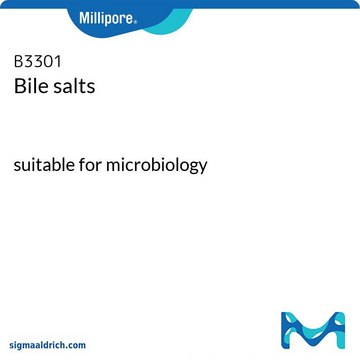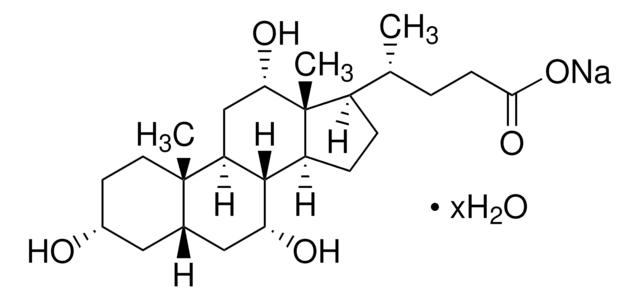B8756
Bile salts
suitable for microbiology
Sinonimo/i:
Bile acids sodium salt, cholic acid-deoxycholic acid sodium salt mixture
Autenticatiper visualizzare i prezzi riservati alla tua organizzazione & contrattuali
About This Item
Codice UNSPSC:
41106212
NACRES:
NA.85
Prodotti consigliati
Sterilità
non-sterile
Livello qualitativo
Forma fisica
powder
Solubilità
distilled water: freely soluble
applicazioni
microbiology
Temperatura di conservazione
10-30°C
Descrizione generale
Bile salt is an organic sodium salt with a conjugate of any of the bile acids along with either glycine or taurine. Biles salts are composed of four different kinds of bile acids - cholic, deoxycholic, chenodeoxycholic and lithocholic acids.Bile salts are extracted under controlled conditions from purified fresh bile, to be used in bacteriological culture media, where it behaves as a selective inhibitory agent that enables isolation and identification of pathogens. For example, in MacConkey Agar/Broth.
Applicazioni
Bile salts may be used as one of the selective agents to prevent the growth of injured Escherichia coli cells, in an experiment done in order to identify the specific agent in the selective media which would inhibit the growth of the injured Escherichia coli ML30 cells. It may also be used for identification of isolates of Vibrio (Beneckea) vulnificus which is a halophilic bacterium, found responsible for causing several human infections.
Altre note
Mixture of sodium cholate and sodium deoxycholate
Codice della classe di stoccaggio
11 - Combustible Solids
Classe di pericolosità dell'acqua (WGK)
WGK 3
Punto d’infiammabilità (°F)
Not applicable
Punto d’infiammabilità (°C)
Not applicable
Dispositivi di protezione individuale
Eyeshields, Gloves, type N95 (US)
Scegli una delle versioni più recenti:
Possiedi già questo prodotto?
I documenti relativi ai prodotti acquistati recentemente sono disponibili nell’Archivio dei documenti.
I clienti hanno visto anche
Daniela Andrea Ramirez et al.
Food chemistry, 215, 493-500 (2016-08-21)
Organosulphur compounds (OSCs) present in garlic (Allium sativum L.) are responsible of several biological properties. Functional foods researches indicate the importance of quantifying these compounds in food matrices and biological fluids. For this purpose, this paper introduces a novel methodology
Christina S Faherty et al.
Molecular microbiology, 85(1), 107-121 (2012-05-11)
Shigella flexneri is a Gram-negative pathogen that invades the colonic epithelium. While invasion has been thoroughly investigated, it is unknown how Shigella first attaches to the epithelium. Previous literature suggests that Shigella utilizes adhesins that are induced by environmental signals
Lian-Hua Cui et al.
Journal of microbiology and biotechnology, 28(4), 510-519 (2018-02-01)
Synbiotics are a combination of probiotics and prebiotics, which lead to synergistic benefits in host welfare. Probiotics have been used as an alternative to antibiotics. Among the probiotics, Pediococcus acidilactici (PA) has shown excellent antimicrobial activity against Salmonella Gallinarum (SG)
Gordana Panic et al.
Parasites & vectors, 6, 237-237 (2013-08-15)
Echinostomiasis is one of the major food-borne trematodiases and the species Echinostoma caproni serves as a useful model for trematocidal drug discovery. The current in vitro drug sensitivity assay uses adult E. caproni worms that are incubated with candidate drugs
Luis Noriega et al.
International journal of food microbiology, 94(1), 79-86 (2004-06-03)
Six derivatives with increased resistance to ox gall (MIC: > or = 1% w/v) and one derivative resistant to sodium cholate (MIC: 0.8% w/v) were obtained from more sensitive original Bifidobacterium strains. These microorganisms, and two additional cholate resistant derivatives
Il team dei nostri ricercatori vanta grande esperienza in tutte le aree della ricerca quali Life Science, scienza dei materiali, sintesi chimica, cromatografia, discipline analitiche, ecc..
Contatta l'Assistenza Tecnica.











